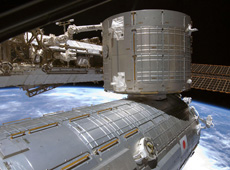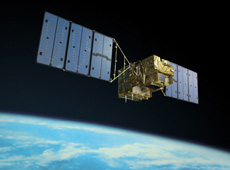

Q. How was 2008 for JAXA? Among all of JAXA's achievements last year, what were the missions or projects that drew attention in and beyond Japan?
In 2008, achievements were particularly outstanding in the following three areas.
First, in the area of space applications, the Advanced Land Observing Satellite “Daichi”(ALOS), launched in 2006, made great global contributions in disaster monitoring, and received praise from China and other Asian countries. Late last year, we were asked by the United Nations Educational, Scientific and Cultural Organization (UNESCO) to use Daichi to photograph ten World Heritage Sites, mainly in Asia, twice a year, for monitoring and protection purposes. Also, we launched the Wideband InterNetworking engineering test and Demonstration Satellite “KIZUNA”(WINDS), and achieved the fastest ever satellite communications speed - 1.2 Gbps. Experimentation for KIZUNA's practical application is already underway, so another important task from now on will be to develop practical uses for satellites, such as KIZUNA, whose advanced technology has already been tested and validated.
Secondly, in the area of space exploration, the SELenological and ENgineering Explorer “KAGUYA”(SELENE), launched in 2007, brought us great results. Among them are the images of full Earth-rise and full Earth-set taken by its onboard high definition camera, which were applauded around the world. In terms of its primary scientific mission, KAGUYA has almost completed planned operations, and entered an extended operation phase at the end of 2008. The major scientific results of KAGUYA thus far are: 1) precise topographic mapping of the Moon with laser altimeter data, in collaboration with the National Astronomical Observatory of Japan and the Geographical Survey Institute; 2) detecting a trace created by Apollo 15's jet engine with its Terrain Camera data; 3) confirming long-term magma eruption activity on the far side of the Moon; and 4) confirming the lack of any trace of water ice in the permanent shadows at the lunar poles. These results from KAGUYA have been featured in Science magazine in the United States.
Finally, the third area is around the International Space Station. 2008 was a landmark year, with the installation of Japan's first manned space facility, the Japanese Experiment Module “Kibo”(JEM). In March, astronaut Takao Doi attached the Experiment Logistics Module Pressurized Section, and in June, astronaut Akihiko Hoshide attached the Pressurized Module and the robot arm to the ISS. Experiments on Kibo finally began in August, and many significant results are anticipated.
In 2008, achievements were particularly outstanding in the following three areas.
First, in the area of space applications, the Advanced Land Observing Satellite “Daichi”(ALOS), launched in 2006, made great global contributions in disaster monitoring, and received praise from China and other Asian countries. Late last year, we were asked by the United Nations Educational, Scientific and Cultural Organization (UNESCO) to use Daichi to photograph ten World Heritage Sites, mainly in Asia, twice a year, for monitoring and protection purposes. Also, we launched the Wideband InterNetworking engineering test and Demonstration Satellite “KIZUNA”(WINDS), and achieved the fastest ever satellite communications speed - 1.2 Gbps. Experimentation for KIZUNA's practical application is already underway, so another important task from now on will be to develop practical uses for satellites, such as KIZUNA, whose advanced technology has already been tested and validated.
Secondly, in the area of space exploration, the SELenological and ENgineering Explorer “KAGUYA”(SELENE), launched in 2007, brought us great results. Among them are the images of full Earth-rise and full Earth-set taken by its onboard high definition camera, which were applauded around the world. In terms of its primary scientific mission, KAGUYA has almost completed planned operations, and entered an extended operation phase at the end of 2008. The major scientific results of KAGUYA thus far are: 1) precise topographic mapping of the Moon with laser altimeter data, in collaboration with the National Astronomical Observatory of Japan and the Geographical Survey Institute; 2) detecting a trace created by Apollo 15's jet engine with its Terrain Camera data; 3) confirming long-term magma eruption activity on the far side of the Moon; and 4) confirming the lack of any trace of water ice in the permanent shadows at the lunar poles. These results from KAGUYA have been featured in Science magazine in the United States.
Finally, the third area is around the International Space Station. 2008 was a landmark year, with the installation of Japan's first manned space facility, the Japanese Experiment Module “Kibo”(JEM). In March, astronaut Takao Doi attached the Experiment Logistics Module Pressurized Section, and in June, astronaut Akihiko Hoshide attached the Pressurized Module and the robot arm to the ISS. Experiments on Kibo finally began in August, and many significant results are anticipated.

Wideband InterNetworking engineering test and Demonstration Satellite, KIZUNA

Full Earth rise imaged by KAGUYA

Japanese Experiment Module Kibo (Courtesy of NASA/JAXA)
Q. The Basic Space Law was enacted last May. How do you think it will change Japan's space strategy? Also, the law mentions revision of space institutions, including JAXA. How is this going to change JAXA?

The Basic Space Law established the new Strategic Headquarters for Space Policy, to be chaired by the Prime Minister. In May 2009, the Basic Space Plan will come into effect as a national strategy for Japan. This is very significant progress, as the United States, Russia, China and India have already made space development a part of their national strategies.
The Basic Space Plan has five pillars, or objectives: 1) building prosperity; 2) contributing to national security; 3) promoting diplomacy; 4) developing industries; and 5) investing in national dreams and in the next generation, through projects such as planetary exploration and human space activity. JAXA is involved in almost all of these objectives, and it is essential to continue to reinforce JAXA's structure. A working group has been formed to find ways to bolster JAXA, and its recommendations will be reflected in our organization by the spring or summer. In accordance with the Basic Space Law, we are ready to maximize the use of our technologies and experience for Japanese space utilization.

The Basic Space Law established the new Strategic Headquarters for Space Policy, to be chaired by the Prime Minister. In May 2009, the Basic Space Plan will come into effect as a national strategy for Japan. This is very significant progress, as the United States, Russia, China and India have already made space development a part of their national strategies.
The Basic Space Plan has five pillars, or objectives: 1) building prosperity; 2) contributing to national security; 3) promoting diplomacy; 4) developing industries; and 5) investing in national dreams and in the next generation, through projects such as planetary exploration and human space activity. JAXA is involved in almost all of these objectives, and it is essential to continue to reinforce JAXA's structure. A working group has been formed to find ways to bolster JAXA, and its recommendations will be reflected in our organization by the spring or summer. In accordance with the Basic Space Law, we are ready to maximize the use of our technologies and experience for Japanese space utilization.
Q. The Greenhouse Gases Observing Satellite “IBUKI”(GOSAT) will be launched in January. How is this mission viewed in Japan and abroad?
The primary objective of IBUKI is to monitor carbon dioxide and methane gas, which are both major causes of global warming, and this mission is garnering interest around the world. IBUKI has about 56,000 observation points around the world to measure the global distribution of greenhouse gas, while only about 280 observation points are available for ground observation. NASA is planning to launch the Orbiting Carbon Observation satellite around the same time as the launch of IBUKI, and we'll be exchanging observation data from the two satellites to improve the accuracy of our measurements.
The IBUKI mission is part of the Global Earth Observation System of Systems (GEOSS), with 76 nations and 51 international organizations taking part. The acceleration of GEOSS was discussed at the G8 Hokkaido Toyako Summit held last July. IBUKI's observations are expected to be extremely helpful for action on global warming, including the United Nations Framework Convention on Climate Change and the Kyoto Protocol.
Related Link: Greenhouse Gases Observing Satellite “IBUKI”(GOSAT)
The IBUKI mission is part of the Global Earth Observation System of Systems (GEOSS), with 76 nations and 51 international organizations taking part. The acceleration of GEOSS was discussed at the G8 Hokkaido Toyako Summit held last July. IBUKI's observations are expected to be extremely helpful for action on global warming, including the United Nations Framework Convention on Climate Change and the Kyoto Protocol.
Related Link: Greenhouse Gases Observing Satellite “IBUKI”(GOSAT)
 Greenhouse Gases Observing Satellite, IBUKI
Greenhouse Gases Observing Satellite, IBUKI